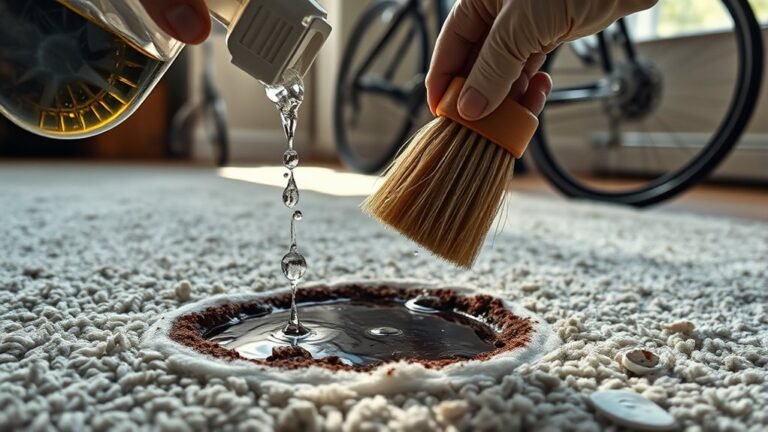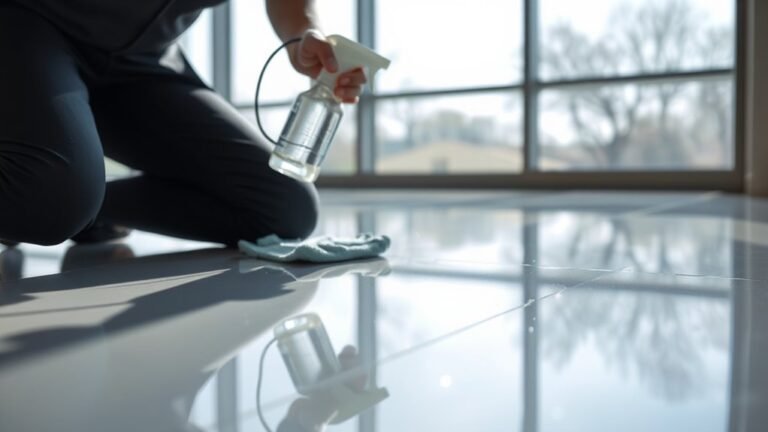Deep Cleaning Checklist for Laminate
To deep clean your laminate floors, start by clearing furniture and debris carefully to avoid scratches. Use a microfiber mop and pH-neutral cleaner for gentle but effective dirt removal. Focus on seams with a soft brush or vacuum crevice tool to prevent buildup. Quickly tackle stains like coffee or grease with appropriate cleaners, and always use a damp mop—not soaked—to avoid water damage. Dry thoroughly with a clean cloth or mop. Keep going to discover how to maintain shine and prevent damage long term.
Preparing Your Laminate Floors for Deep Cleaning

Before you begin deep cleaning your laminate floors, it’s important to clear the area of any furniture and debris. This step not only gives you full access but also prevents damage to your floors and furniture. Make certain you move everything carefully to avoid scratches. Next, consider your floor protection—using pads under furniture legs after cleaning can maintain your floor’s pristine condition. Sticking to a consistent cleaning schedule helps keep dirt and grime from building up, making deep cleaning less intimidating. By preparing your floors properly and planning regular care, you’ll enjoy the freedom of a spotless, beautiful space without unnecessary hassle. Taking these simple steps guarantees your laminate flooring stays durable and looks great for years to come.
Essential Tools and Cleaning Products
To deep clean your laminate floors effectively, you’ll need a handful of essential tools and the right cleaning products. Choosing quality cleaning supplies helps you maintain your floors’ beauty without restrictions. Equip yourself with items that make the process smooth and protect your floors long-term.
Here are the essentials you should have on hand:
- Microfiber mop: gentle yet effective at lifting dirt without scratching.
- pH-neutral laminate cleaner: safe and powerful, preserving your floor’s finish.
- Floor protectors: pads for furniture legs to prevent damage during and after cleaning.
With these tools, you’re free to maintain a spotless floor while safeguarding it against wear. Investing in the right cleaning supplies guarantees your laminate stays pristine, letting you enjoy your space without limits.
Removing Dirt and Debris From Seams

Since dirt and debris tend to accumulate in the seams of laminate flooring, you’ll want to tackle these areas carefully to prevent damage. Start your seam cleaning by using a soft brush or a vacuum with a crevice tool to loosen and remove dirt. Avoid harsh tools that might scratch the surface—your goal is dirt removal without compromising the laminate’s finish. For stubborn debris, dampen a microfiber cloth with a gentle cleaner and run it along the seams, ensuring not to oversaturate. This focused approach keeps your floors looking fresh and extends their life. Remember, regular seam cleaning prevents buildup that can cause warping or mold, giving you the freedom to enjoy your space without worry.
Effective Stain Removal Techniques
When tackling stains on your laminate floors, it helps to know what you’re dealing with first. You can whip up simple homemade solutions that are both effective and gentle. Plus, using the right scrubbing methods will keep your floors safe while getting rid of stubborn marks.
Identifying Common Stains
Five of the most common stains you’ll encounter on laminate floors include coffee, ink, grease, wine, and pet accidents. Recognizing these stain types early helps you tackle them effectively, maintaining your floor’s freedom from permanent marks.
To stay ahead, consider these prevention tips:
- Wipe spills immediately to prevent absorption.
- Use mats in high-risk areas like kitchens and entryways.
- Train pets to reduce accidents on laminate.
Understanding these stains allows you to respond quickly and confidently, avoiding damage that limits your floor’s lifespan. By identifying the stain type, you can choose the right cleaning method and keep your laminate looking fresh and unrestricted. Freedom starts with awareness, so be proactive in spotting and managing stains before they settle in.
Homemade Cleaning Solutions
Although commercial cleaners can be effective, homemade solutions offer a gentle yet powerful way to tackle stains on laminate floors without harsh chemicals. You can mix a vinegar solution—one part white vinegar to three parts water—to break down dirt and grime effortlessly. For tougher stains, sprinkle baking soda directly onto the spot, then spray the vinegar solution over it. The fizzing action helps lift stains without damaging your floor. Let it sit for a few minutes, then wipe clean with a damp cloth. This method gives you control over what touches your floors and avoids unnecessary toxins. By choosing these simple ingredients, you maintain your freedom from harsh chemicals while keeping your laminate floors spotless and fresh.
Safe Scrubbing Methods
Because laminate floors can be sensitive to harsh treatment, you’ll want to use safe scrubbing methods that remove stains without causing damage. Using gentle abrasives allows you to tackle tough spots while preserving the floor’s finish. Microfiber cloths are your best friends here—they’re soft yet effective at lifting dirt.
To keep your freedom intact and floors spotless, try these techniques:
- Lightly dampen a microfiber cloth with a homemade cleaning solution for gentle scrubbing
- Use a soft-bristle brush with gentle abrasives to address stubborn stains carefully
- Avoid excessive water or harsh chemicals that can warp or dull your laminate
With these methods, you’ll maintain your floor’s beauty and enjoy cleaning without restrictions or worries about damage.
Proper Mopping and Drying Methods
When mopping laminate floors, you’ll want to use a damp mop rather than soaking it to prevent water damage. Choosing the right mop type is key—microfiber mops work great since they hold just enough moisture and avoid over-wetting the surface. Avoid heavy sponge mops that can leave puddles behind. After mopping, dry your floors promptly using effective drying techniques. You can use a dry microfiber cloth or a clean, dry mop to absorb leftover moisture quickly. Open windows or turn on fans to speed up air circulation, helping your floors dry evenly and preventing warping. By mastering these proper mopping and drying methods, you keep your laminate floors looking fresh while enjoying the freedom of a clean, damage-free space.
Maintaining Shine and Preventing Damage

After properly mopping and drying your laminate floors, you’ll want to focus on maintaining their shine while preventing damage. Shine maintenance isn’t just about looks—it’s about preserving the freedom your floors give you to enjoy your space without worry. For effective damage prevention and lasting shine, keep these in mind:
- Use furniture pads to avoid scratches when moving items.
- Clean spills immediately to prevent warping or stains.
- Avoid harsh cleaners; opt for products designed for laminate floors.
Frequently Asked Questions
Can Laminate Floors Be Steam Cleaned Safely?
You might wonder if steam cleaning is safe for your laminate floors. While steam cleaning can be tempting for its deep-cleaning power, it’s generally not recommended because excessive moisture and heat can damage laminate safety by warping or swelling the boards. Instead, you’ll want to stick with a damp mop and gentle cleaner to keep your floors looking great without risking damage. This way, you keep your freedom to enjoy beautiful floors worry-free.
How Often Should Deep Cleaning Be Done on Laminate Floors?
Imagine Sarah, who loves hosting weekend parties. She follows frequency guidelines by deep cleaning her laminate floors every three months to keep them spotless despite heavy foot traffic. You should aim for a similar routine, adjusting based on your lifestyle. Regular deep cleaning helps maintain that fresh look and prevents buildup. Combine this with maintenance tips like quick spill cleanups to enjoy free, worry-less living on beautiful floors.
Are Homemade Cleaning Solutions Safe for Laminate Floors?
You might wonder if homemade solutions are safe for laminate floors. The good news is, they can be—if you keep laminate safety in mind. Avoid harsh chemicals or excessive water, and stick to gentle mixtures like vinegar and water in small amounts. This way, you maintain your freedom to clean naturally without risking damage. Just be sure to test any homemade solution on a small spot first to protect your floors.
Can Laminate Flooring Be Refinished or Repaired?
Imagine trying to give your laminate floors a facelift with a magic wand—spoiler: it’s not that simple. You can’t really go refinishing laminate like real hardwood; it’s more like a laminate makeover, not a full renovation. For small laminate repairs, you might patch scratches or replace damaged planks, but freedom means accepting limits. So, instead of dreaming of sanding and staining, embrace smart fixes and keep your floors looking fresh without breaking the rules.
What Humidity Levels Are Ideal for Laminate Flooring Maintenance?
You’ll want to keep humidity levels between 35% and 55% to avoid humidity effects like warping or gaps in your laminate flooring. Maintaining this range helps your floor stay stable and looking great. One of the best maintenance tips is using a humidifier or dehumidifier depending on the season, giving you the freedom to enjoy your space without worrying about damage. It’s all about balance for lasting beauty!






